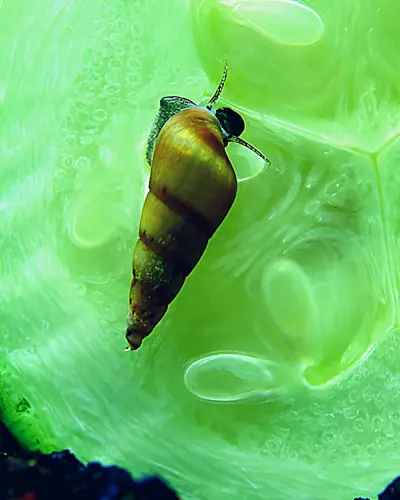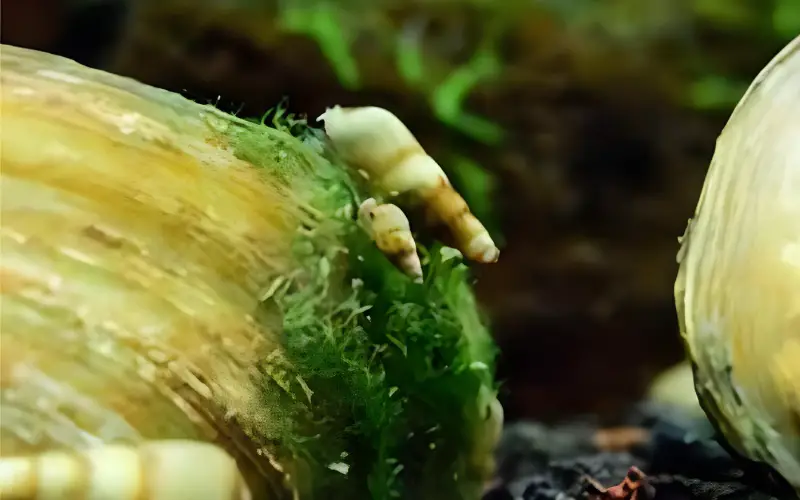Are Malaysian Trumpet Snails good additions to your underwater world or troublemakers in a pretty shell? These tiny snails, often hitchhiking their way into tanks unnoticed, can quickly establish a thriving population.
Aquarium hobbyists are always looking for the perfect balance—creatures that are fascinating to observe, contribute to a healthy ecosystem, and don’t cause havoc in a carefully curated environment.
Enter the Malaysian Trumpet Snail, a little critter that has stirred up big debates in the aquatic community.

This is a welcome cleanup crew, diligently clearing algae and leftover food for some. For others, it’s an invasion that raises concerns about overpopulation and potential damage to delicate plants.
Join us as we delve into the pros and cons of keeping Malaysian Trumpet Snails, explore their impact on tank environments, debunk myths, and help you decide whether these intriguing invertebrates are friends or foes in your aquarium journey.
Table of Contents
ToggleAre Malaysian Trumpet Snails Good for Aquarium?
Malaysian Trumpet Snails: A Perfect Match for Shrimp Tanks? For several reasons, Malaysian Trumpet Snails can be a fantastic addition to shrimp tanks.
These tiny, peaceful snails are crucial in maintaining a healthy and balanced ecosystem, especially for our delicate shrimp friends.
Are Malaysian trumpet snails beneficial?
Here’s why they’re a great match:
- Natural Algae Eaters: Malaysian Trumpet Snails are efficient algae eaters, constantly grazing on algae buildup on surfaces and within the substrate. This helps keep the tank clean and prevents algae overgrowth, which can harm shrimp’s health.
- Substrate Aeration: As they burrow and move through the substrate, these snails prevent the formation of anaerobic pockets (areas lacking oxygen) that can lead to harmful gas buildup. This is particularly beneficial for shrimp, as they are sensitive to poor water quality.
- Bioload Maintenance: Malaysian Trumpet Snails contribute to the tank’s overall bioload, providing a consistent source of waste for beneficial bacteria to break down. This helps maintain a stable nitrogen cycle and prevents the tank from “re-cycling” due to a lack of bioload, which can be stressful for shrimp.
- Peaceful Coexistence: Malaysian Trumpet Snails are quiet and pose no threat to shrimp or other freshwater snails. They mind their own business, focusing on their cleanup duties and coexisting harmoniously with their tank mates.
In conclusion, Malaysian Trumpet Snails are highly beneficial for shrimp tanks, contributing to a clean, stable, and healthy environment for these delicate invertebrates to thrive.
Great Clean-Up Crew Overview: Are Trumpet Snails Good for Aquarium
Trumpet snails can be a great addition to a planted aquarium, but there are some things to consider before adding them.

On the plus side, trumpet snails are excellent scavengers. This snail eats uneaten food, residue, and algae, helping to keep your tank clean. They also burrow in the substrate, which helps to aerate it and prevent it from becoming compacted.
However, trumpet snails can reproduce very quickly, especially if a large amount of food is available in the tank. If you are not careful, they can quickly overrun your aquarium.
Here are some things to keep in mind if you are considering adding trumpet snails to your aquarium:
- Tank size: Trumpet snails can do well in various tank sizes, but they are best suited for larger tanks (20 gallons or more). This will give them plenty of space to roam and reproduce.
- Substrate: Trumpet snails prefer to burrow in sand or gravel. They will not do well in a tank with no substrate or a substrate that is too fine (such as sand).
- Feeding: Don’t overfeed your fish; this will provide more food for the trumpet snails to reproduce.
- Predators: If you have fish that eat snails, such as puffers or loaches, they may help to control the trumpet snail population.
Overall, trumpet snails can be a beneficial addition to a planted aquarium, but knowing their potential to reproduce quickly is essential. If you are willing to take some steps to control their population, they can be a valuable asset to your tank.
Malaysian Trumpet Snails in Shrimp Tanks: Weighing the Pros and Cons
Malaysian Trumpet Snails often spark debate among shrimp tank enthusiasts. While they offer several benefits, there are also potential drawbacks before introducing them to your shrimp haven. Let’s delve into the pros and cons:
Pros:
- Exceptional Cleaners: These snails are tireless algae eaters, keeping your tank surfaces and substrate free from unsightly algae buildup. This enhances the aesthetic appeal and contributes to a healthier environment for your shrimp.
- Substrate Aeration: By burrowing through the substrate, Malaysian Trumpet Snails prevent the formation of anaerobic zones, ensuring proper oxygenation and preventing harmful gas pockets that can harm shrimp health.
- Bioload Contribution: They provide a consistent source of waste, which helps maintain a stable nitrogen cycle and prevents the tank from experiencing sudden shifts in water parameters that can stress shrimp.
- Peaceful Tank Mates: Malaysian Trumpet Snails are peaceful and pose no threat to shrimp or other pond snails, making them ideal for community tanks.
- Population Control: While they can reproduce quickly, the available food supply generally regulates their population growth. Their numbers will naturally stabilize in a well-maintained tank with limited excess food.
Cons:
- Potential Overpopulation: In tanks with excessive food or decaying organic matter, Malaysian Trumpet Snails can reproduce rapidly, leading to a population explosion.
- Live Plant Damage: While not their primary food source, some snail species may nibble on delicate or decaying plant leaves, which can concern planted shrimp tanks.
- Aesthetic Concerns: For those who prefer a pristine and minimalist aquascape, the presence of live young snails crawling on surfaces may be undesirable.
The Verdict:
Malaysian Trumpet Snails can be valuable additions to shrimp tanks, offering significant benefits in maintaining a clean and balanced ecosystem. However, it’s crucial to be mindful of potential overpopulation and take steps to manage their numbers if necessary. By understanding the pros and cons, you can make an informed decision about whether these industrious invertebrates fit your shrimp tank.
Commonly Asked Questions about the Pros and Cons of Malaysian Trumpet Snails (FAQs)
Are Malaysian trumpet snails good for algae?
Malaysian trumpet snails aren’t the best for algae in a planted tank. They mainly eat detritus and may nibble on algae but are less effective than dedicated algae eaters.
What is the problem with Malaysian trumpet snails?
The main issue with Malaysian Trumpet Snails (MTS) is their rapid breeding. They can breed quickly and overrun aquariums, though they benefit the tank by turning substrate and eating detritus.
Are Malaysian trumpet snails good algae eaters?
Malaysian trumpet snails are decent algae eaters for diatoms and soft algae on glass, but there are better ones. They primarily scavenge detritus and leftover fish food. Consider ramshorn or nerite snails for a more dedicated algae patrol.
Are Malaysian trumpet snails good to eat?
Malaysian trumpet snails are not typically considered edible. They are aquarium cleaners, not a food source.
What do Malaysian trumpet snails do?
Malaysian trumpet snails are beneficial aquarium cleaners. They burrow in the gravel, sifting out waste and leftover food, keeping your tank healthy for long periods.
How to control the Malaysian trumpet snail population?
Malaysian trumpet snails can become a pest. To remove them, reduce fish food as they eat leftovers. Manually pick out adult snails and watch for baby snails on the glass. Dwarf puffers, assassin snails, or loaches can also help control the population, but research their tank compatibility first.
Are Malaysian trumpet snails bad?
Malaysian trumpet snails can be beneficial or a nuisance. They aerate substrate and eat waste but reproduce quickly. To control them, limit food and consider predator snails. Their eggs are tiny and hard to see.
How do you get rid of Malaysian trumpet snails?
Controlling Malaysian Trumpet Snail populations requires a multi-pronged approach. Reduce excess food, manually remove snails, and consider natural predators. Research more detailed information on practical methods.
Conclusion
So, are malaysian trumpet snails good for aquarium? As we’ve journeyed through Malaysian Trumpet Snails, we’ve uncovered a nuanced reality. These tiny creatures are neither heroes nor villains but, instead, organisms playing a specific role within the delicate ecosystem of your aquarium. Their presence brings benefits and challenges, and the key to a harmonious tank lies in understanding and managing their impact.
By maintaining a clean environment, avoiding overfeeding, and potentially introducing natural predators, you can keep snail populations in check while reaping the rewards of their algae-eating and substrate-aerating prowess. Remember, a thriving aquarium is built on balance, and even the smallest inhabitants, like the Malaysian Trumpet Snail, play a part in that intricate dance.
So, are Malaysian Trumpet Snails suitable for your aquarium? The answer depends on your approach and your tank’s specific needs. With careful observation and proactive management, these little snails can become valuable contributors to a healthy and fascinating underwater world.
You might also like
- Australian Trumpet Snails 101: Ultimate Syrinx Aruanus Guide
- How Big Do Malaysian Trumpet Snails Get: (Expert Guide)
- How Fast Do Malaysian Trumpet Snails Breed: (Ultimate Guide)
- Malaysian Trumpet Snails Eggs 101: (How to Identify & Care)
- How to Get Rid of Malaysian Trumpet Snails! (3 Proven Ways)
- Can Trumpet Snails Live Out of Water: (Answered)
- Breeding Trumpet Snails in Aquariums: Complete Beginner’s Guide
- Malaysian Trumpet Snail Infestation: (4 Secrets to Control!)
- Do Malaysian Trumpet Snails Clean Aquariums: (5 Myths DEBUNKED!)
- Tarebia Granifera Aquariums 101: (A Comprehensive Guide!)
- Spot Malaysian Trumpet Snail Baby With These 3 Easy Clues!
- Malaysian Trumpet Snails tank Size: 5 HUGE facts you NEED to know




